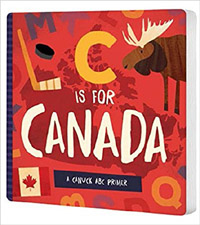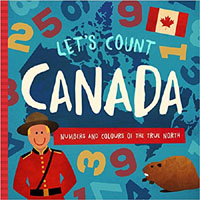| ________________
CM . . .
. Volume XXIII Number 28. . . .March 31, 2017

 |
C is for Canada: A Canuck ABC Primer.
Trish Madson. Designed and illustrated by David W. Miles.
Sanger, CA: Familius (Distributed in Canada by Raincoast Books), 2017.
20 pp., board book, $17.99.
ISBN 978-1-9448-2289-7.
Preschool / Ages 2-4.
Review by Dave Jenkinson.
** /4
|
| |
|
 |
Let’s Count Canada: Numbers and Colours of the True North.
Trish Madson. Designed and illustrated by David W. Miles.
Sanger, CA: Familius (Distributed in Canada by Raincoast Books), 2017.
20 pp., board book, $17.99.
ISBN 978-1-9448-2291-0.
Preschool / Ages 2-4.
Review by Dave Jenkinson.
*** /4
|
| |
|

excerpt:
C iS FOR CARiBOU
D iS FOR DOLPHiN
E iS FOR EH?
F iS FOR FLANDERS FiELDS
G iS FOR GANDER iNTERNATIONAL AiRPORT (From C is for CANADA: A CANUCK ABC PRIMER.)
3 BLACK CANADiAN GEESE
FLY HiGH iN A V
4 WHITE POLAR BEARS
PLAY BY THE SEA (From Let’s Count Canada: Numbers and Colours of the True North.)
The content of this pair of board books could form the “core curriculum” for a child’s early learnings: recognizing and naming the letters of the alphabet and the major colours as well as being able to count from 1 to 10 while expanding vocabulary.
C is for Canada: A Canuck ABC Primer is an acceptable “Canadian” ABC book, but it could have been improved. Each letter is presented in upper case only, and each page contains one or two letters. As can be seen in the above excerpt, a sentence is used to name the “thing” that David W. Miles has illustrated to represent the letter. Miles’ uncluttered illustrations make it easy for young “readers” to know on what it is that they should focus. While author Trish Madson has made some good Canadian letter/object choices (ARCTIC CHAR, BEAVER, CARIBOU, iGLOO, NORTHERN LiGHTS, POLAR BEAR, SASKATOON and TOQUE), where C is for Canada falls short is in some of Madson’s other selections of things to represent Canada. “E iS FOR EH?” is “cute’ but essentially meaningless to the book’s intended young audience (who will hear “E is for A” Confusing?!) While “F iS FOR FLANDERS FiELDS” has a Canadian history connection, the example will not resonate with preschoolers, nor will the illustration of two poppies. Canadian place names, “G iS FOR GANDER iNTERNATIONAL AiRPORT, “K iS FOR KANANASKiS COUNTRY”, and “Y iS FOR YELLOWKNiFE”, present Miles with major illustration challenges. For example, the illustration accompanying “Y iS FOR YELLOWKNiFE” ends up being just a road sign with the word “YELLOWKNiFE” on it. Admittedly, “X” is always a challenging letter in any ABC book, but “X iS FOR XYLOPHONE” has no Canadian connection whatsoever. A note at the bottom of the page for “U iS FOR UFO LANDING PAD” indicates this structure is to be found in St. Paul, Alberta, but there is no location note for “O iS FOR OGOPOGO”, a lake monster that reportedly lives in BC’s Okanagan Lake. And then there is the question of why every “I” is in lower case.
The numbers from 1 to 10 and the colours blue, brown, black, white, purple, yellow, grey, green, orange and red make up the content of Let’s Count Canada: Numbers and Colours of the True North. Each colour/number combination occupies a double-page spread, and the text for each pair of double-page spreads rhymes. With the exception of the viola that is used to illustrate blue and the pumpkins for orange, the beavers, Canadian geese, polar bears, Saskatoon berries, wolves, garter snakes and maple leaves are definitely associated with Canada. In terms of representing colours, Miles’ (collage?) illustrations are generally excellent, with some exceptions. The Canadian goose was chosen to represent black, but that colour really does not dominate in Miles’ image of three geese in flight. “7 FURRY GREY WOLVES RUN iN A PACK”, but only two are clearly grey while the other five wolves have mottled fur in which other colours predominate. Miles’ images, in addition to providing the necessary colours, also are the sources of the items to be counted. With one exception, children should have minimal difficulty in locating what is to be counted. In the “5 PURPLE SASKATOON BERRiES HANG ON A BRANCH” pages, four berries are quire obvious, but the fifth, and very ripe, berry “hides” in the shade. Because items related to the higher numbers, 8, 9 and 10, respectively snakes, pumpkins and maple leaves, are randomly arranged on the pages, the younger members of the book’s audience may miss or double count something.
Once more, I have to question why every “I” is also in lower case in Let’s Count Canada: Numbers and Colours of the True North.
Recommended.
Dave Jenkinson, CM’s editor, lives in Winnipeg, MB.

To comment
on this title or this review, send mail to cm@umanitoba.ca.
Copyright © the Manitoba Library Association. Reproduction for personal
use is permitted only if this copyright notice is maintained. Any
other reproduction is prohibited without permission.
Next Review | Table of Contents For This Issue - March 31, 2017
CM Home | Back Issues
| Search
| CM Archive
| Profiles Archive
|

